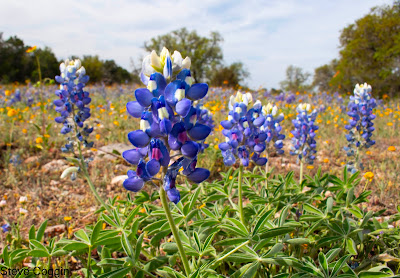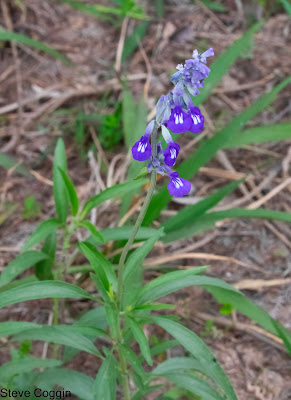 |
| Crossvine (Bignonia capreolata) flowers. Davidson County, North Carolina. |
In the plant kingdom, vinyness runs in families. The vine growth habit has evolved many times among the flowering plants and often the closest relatives of vine is also a vine.
 |
| Crossvine in flower. Mecklenburg County, North Carolina. |
Crossvine (Bignonia capreolata) is a woody vine in the Family Bignoniaceae. This family is found around the world and with about 850 species and includes trees, herbs and many vines. One of these is Trumpet Creeper (Campsis radicans), a vine that made an appearance in an earlier blog. Crossvine is native to the southeastern United States.
 |
| A spray of Crossvine flowers. Davidson County, North Carolina. |
Crossvine produces a cascade of yellow and orange, trumpet-shaped flowers in the spring. Like its relative Trumpet Creeper, Crossvine flowers are favorites of Ruby-throated Hummingbirds (Archilochus colubris). The flowers appear just as hummingbirds are returning from wintering in the tropics and nectar fuels the migration and mating of these tiny birds. The vine climbs using tendrils to latch on to tree trunks and each node bears a pair of leaves, each with two leaflets. The name Crossvine comes from the distinctive X-shaped pith in a cross-section of the vine’s stem.
 |
| Crossvine leaves. Rowan County, North Carolina. |
 |
| Crossvine leaves in winter. Mecklenburg County, North Carolina. |
 |
Cross section. of Crossvine stem showing the X pattern of pith. https://www.fs.usda.gov/wildflowers/plant-of-the-week/Bignonia_capreolata.shtml |
Virginia Creeper (Parthenocissus quinquefolia) is classified in the family Vitaceae. This large family consists, almost exclusively of vines and has a worldwide distribution. I devoted an earlier blog to Grapes (Vitis) the best-known members of this family. The name Virginia Creeper has interesting origins. The common name refers to its viny, creeping habit. The genus Parthenocisscus, is from the Greek parthenos meaning virgin (which is, of course, the basis for the state name of Virginia) and kissos meaning ivy. The specific name quinquefolia is from Latin and meaning five leaves, named for the five leaflets on each Virginia Creeper leaf.
 |
| Compound leaves of Virginia Creeper (Parthenocissus quinquefolia) with five leaflets. Palm Beach County, Florida. |
 |
| Virginia Creeper leavers. Rowan County, North Carolina. |
Virginia Creeper is found in eastern North American from southern Canada to northern Mexico. The leaf structure of Virginia Creeper led to this nursery rhyme. “Leaves of three, let it be. Leaves of five, let it thrive” This rhyme was to help children distinguish Virginia creeper from Poison Ivy (Toxicodendron radicans) that grows in the same area. Virginia Creeper vines grow on trees or walls and attach to these surfaces with short tendrils. In spring, it produces small, inconspicuous white flowers. These flowers develop into purple fruits that resemble grapes and are an important food source for a variety of birds. In the fall Virginia Creeper leaves turn bright red. Because of its fast growth and its ability to climb, Virginia Creeper is planted as a ground cover, trained to arbors or grown up walls.
 |
| Virginia Creeper fruits. Rowan County, North Carolina. |
Crossvine and Virginia Creeper are common native vines that
provide food and cover for wildlife.
These vines and other members of their families are important members of southeastern forest communities.






















